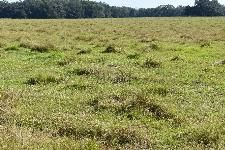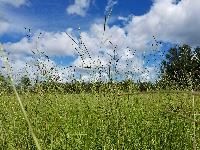Introduction
Brunswickgrass (Paspalum nicorae Parodi) is becoming a problematic weed in summer perennial grass pastures in the Southeast. This plant is native to southern Brazil, northern Argentina, Paraguay, and Uruguay. It was introduced into the US as a soil conservation plant for erosion control and as a potential forage crop. Brunswickgrass is well-adapted to moderately acidic, sandy soils, but it also grows well in sandy loam and well-drained, light to medium clay-based soils. The plant is competitive with bahiagrass and bermudagrass. It can eventually dominate a perennial grass pasture because it is less palatable. Brunswickgrass has become naturalized and has contaminated bahiagrass seed fields and pastures in the southeastern states, including some of the important counties for seed production in Florida, such as Gilchrist, Levy, Alachua, Citrus, and Sumter. This publication provides information on the identification, biology, and management of brunswickgrass for Extension agents, producers, and state and federal agency personnel.
Cattle will consume brunswickgrass when it is young and tender. However, the plant quickly matures and loses palatability, and cattle will avoid it. It proliferates when the more desirable forages have been overgrazed. As it thrives under reduced competition, it spreads and becomes more difficult to eradicate. Pastures contaminated with this grass will appear to have tufts or hills of plants where cattle refuse to graze (Figure 1). Because of the rhizomatous habit of the plant, those patches tend to increase in size year after year and eventually dominate the pasture.

Credit: Marcelo Wallau, UF/IFAS
During the seed cleaning process, brunswickgrass seed does not readily separate from Pensacola bahiagrass seed; both seeds are similar in size and shape. This makes it difficult for bahiagrass seed processors to effectively remove brunswickgrass to meet weed seed specifications for saleable seed. However, brunswickgrass is more readily removed from Argentine bahiagrass due to differences in seed size. There has been an increasing number of reports of brunswickgrass infestations in pastures around the state, and certain measures should be taken to reduce spread. The most effective way to avoid infestation is by using certified seeds when establishing new pastures.
Legislation for Seed Production
Currently, brunswickgrass is not on the Florida Noxious Weed List, and there is no restriction for sales in the state. Seed lots cannot have more than 2% of weeds on a weight basis for commercialization; otherwise, they are condemned and not sellable. More information is available through the Florida Department of Agriculture and Consumer Services Seed Lab (https://www.fdacs.gov/Agriculture-Industry/Seed-Dealer-Licensing).
Brunswickgrass is considered a restricted noxious weed in Alabama and Georgia. The limit of brunswickgrass contaminant for non-certified bahiagrass seeds is 300 seeds per lb in Alabama, and 270 seeds per lb in Georgia. For certified seeds, regardless of precedence or market, it is considered a noxious weed with zero tolerance.
Appearance
Brunswickgrass is a perennial summer grass with a growing season and appearance similar to those of bahiagrass (Figure 2), especially during the vegetative phase. Brunswickgrass often has three to four racemes per seed head (Figure 3, left), while Pensacola bahiagrass (P. notatum var. saurae Parodi) typically has two to three racemes (Figure 3, right) (Hitchcock 1971).

Credit: Marcelo Wallau, UF/IFAS

Credit: Marcelo Wallau, UF/IFAS
Brunswickgrass has a deep and aggressive rhizome system that looks different from bahiagrass rhizomes. Brunswickgrass rhizomes occur below the soil surface (with a depth of approximately 4 in or 10 cm) and spread laterally (Figure 4 B), while bahiagrass rhizomes, which are sometimes referred to as stolons, spread along the soil surface (Figure 4 A).

Credit: Marcelo Wallau, UF/IFAS
Seeds are slightly smaller than those of Pensacola bahiagrass. The seed coat has a dark, chestnut brown center that varies somewhat in size, depending on the variety. The seeds are noticeably convex in shape compared to the relatively flat, tan seeds of Pensacola bahiagrass (Figures 5 and 6). Brunswickgrass may average about 200,000 seeds per pound, based on our estimates.

Credit: Ann Blount, UF/IFAS

Credit: Marcelo Wallau, UF/IFAS
Variety/Germplasm
Brunswickgrass (Paspalum nicorae Parodi) is synonymous with P. plicatulum Michaux. var. arenarium Arechav. It is sometimes referred to as P. lepton Shult. (Oliveira and Valls 2008). Two seed sources were released and promoted for conservation plantings by the Soil Conservation Service (presently Natural Resources Conservation Service—NRCS) from Plant Materials Center in Americus, GA (Belt and Englert 1999; NPGS GRIN Global 2016). ‘Amcorae’ (Origin: Argentina, Source: PI 202044, CPI 21370, ATF 1040) is a bluish-green, vigorous introduction released in 1969. A later release, ‘Doncorae’ (Origin: Brazil, Source: PI 310131, CPI 125877, ATF 1028), occurred in 1993. It has rapid seedling establishment, vigorous growth habit, and winter hardiness.
Management
Brunswickgrass is tetraploid, similar to Argentine-type bahiagrass. While diploid Paspalum species are not tolerant to metsulfuron, tetraploid species/cultivars tend to be tolerant. Similarly, brunswickgrass is also tolerant to metsulfuron. To date, the only selective herbicide that has activity on brunswickgrass is hexazinone. Hexazinone applied at 1 to 2 lb per acre (1 to 2 qt/A Velpar™/Tide Hexazinone™ or 27 to 54 oz/A Velossa™) is effective at killing emerged/established plants. Application of hexazinone should occur from June through September for optimal control. Previous research indicates that bahiagrass growth following hexazinone application may be reduced under certain environmental conditions for approximately 8 to 12 weeks, especially at the higher application rates. Brunswickgrass seedling emergence later in the growing season after herbicide application is common; therefore, it will likely take at least 2 to 3 years of hexazinone applications for complete control. Also, an important consideration is that residual effect of hexazinone can restrict overseeding of cool-season grasses (i.e., small grains and ryegrass) into treated bahiagrass pastures, especially if rainfall is limited following application or if it is applied later in the growing season (i.e., September). If pasture renovation is deemed necessary, glyphosate should be applied at the highest rate allowable in the product label; typically, this is equivalent to 4 qt/A of a 41% glyphosate formulation. Mechanical cultivation alone will not solve the problem; it can aid the spread of brunswickgrass through rhizome segments. A combination of broad-spectrum herbicides (e.g., glyphosate), mechanical cultivation, and crop rotation may provide successful control of brunswickgrass in heavily infested areas, because seed survival in the soil seed bank is not believed to be long-term.
The best preventive action to avoid further distribution of this grass is to refrain from harvesting contaminated fields and to always use certified seeds when establishing new pastures. Certified (“blue tag”) seed has been produced under strict production guidelines that minimize the risk of weed contamination. It is important to remember that large quantities of bahiagrass seed are sold without any field inspections for purity, which can result in brunswickgrass infestation while planting new pastures. Therefore, certified seed need to be purchased from a reliable company or source.
References
Belt, S. V., and J. M. Englert. 1999. “Improved Conservation Plant Materials Released by NRCS and Cooperators through December 2007.” United States Department of Agriculture Natural Resources Conservation Service. Accessed on March 17, 2017. http://www.nrcs.usda.gov/Internet/FSE_DOCUMENTS/nrcs144p2_064674.pdf
Hitchcock, A. S. 1950. Manual of the Grasses of the United States, 2nd Edition. New York, NY: Dover Publications, Inc.
NPGS GRIN Global. 2016. U.S. National Plant Germplasm System. Accessed on March 17, 2017. https://npgsweb.ars-grin.gov/gringlobal/search.aspx
De Oliveira, R. C., and J. F. M. Valls. 2008. “Novos sinônimos e ocorrências em Paspalum L. (Poaceae) [New Synonyms and Occurrences in Paspalum L. (Poaceae)].” Hoehnea 35(2): 289–295.
Additional References
Alderson, J., and W. C. Sharp. 1994. “Grass Varieties in the United States.” Agriculture Handbook 170. Washington, D.C.: USDA, SCS.
Burson, B. L., and H. W. Bennett. 1970. “Cytology, Method of Reproduction, and Fertility of Brunswickgrass, Paspalum nicorae Parodi.” Crop Science 10:184–187.
Evers, G. W., and B. L. Burson. 2004. “Dallisgrass and Other Paspalum Species.” In Warm-Season (C4) Grasses. Agronomy Monograph 45, edited by L. E. Moser, B. L. Burson, and L. E. Sollenberger. 681–713. Madison, WI: ASA, CSSA, and SSSA.
Hacker, J. B., R. J. Williams, A. M. Vieritz, B. G. Cook, and B. C. Pengelly. 1999. “An Evaluation of a Collection of Paspalum Species as Pasture Plants for Southeast Queensland.” Genetic Resources Communication No. 32. St Lucia, QLD, Australia: CSIRO Tropical Agriculture.
Table 1. Comparison chart of brunswickgrass and Pensacola bahiagrass.